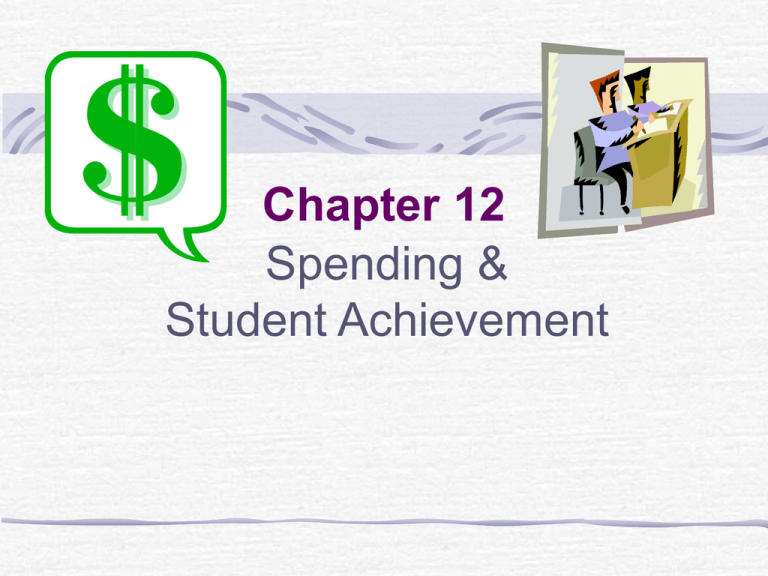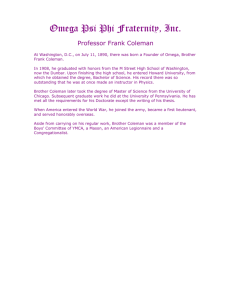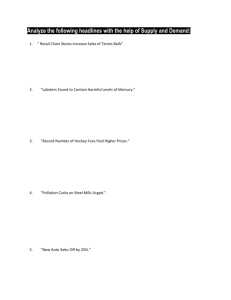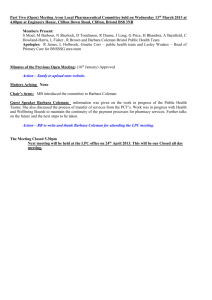Chapter 12 Spending & Student Achievement
advertisement

Chapter 12 Spending & Student Achievement • Questions about financial resources’ impact on education lie at the heart of national education reform • A Nation at Risk’s publication prompted some to seriously question public schools’ value if teaching interventions could not overcome the destiny of children’s backgrounds • Does public education make a difference in student achievement apart from family influences? • Educational leaders need to know where they can get the “biggest bang for the instructional buck” in advancing student achievement • The 3rd ISLLC Standard states: A school administrator is an educational leader who promotes the success of all students by ensuring management of the organization, operations, & resources for a safe, efficient, & effective learning environment. The Coleman Report,1966 • The Coleman Report changed the country’s attitude about public education • This study focused on questions of racial segregation and educational inequality by examining: – Physical facilities, curriculum, teacher characteristics, and student achievement as measured by standardized test scores – Student self-attitudes and academic goals, socio-economic status, and parent education levels Coleman Study Findings • The Coleman study findings were interpreted to say that schools had little impact on student achievement outside of the family background • Educational inputs (such as, studentteacher ratio, funding resources, teaching practices, quality of school facilities) did not appear to contribute much to student achievement Coleman Study Findings, cont. This study’s results led to current thinking that spending levels on education do not have a significant impact student achievement Coleman Study Findings, cont. • This finding made the report particularly influential in some educational and political circles Coleman Study & Educational Spending • The Coleman study’s results led to some current thinking that education spending levels do not have a significant impact student achievement • To some politicians and policy makers, this study justified reducing taxes Other Studies Indicated Positive Spending Outcomes • Studies concurrent with Coleman indicated positive outcomes with school spending and student outcomes • These studies examined later earnings of individuals in the labor force and found a significant association between adult earnings and school spending • Verstegan states that these findings have been strong and consistent over time Coleman Study Had Political Impact & Momentum • Unfortunately, Coleman’s study overshadowed the others relegating them rather obscurity Coleman Report Fallout • The findings made conservative politicians seriously question public schools’ value if educational interventions could not overcome the destiny of children’s backgrounds • Many public school educators & most college and university professors, on the other hand, remained relatively quiet, waiting for further research findings, believing that classroom interventions made a significant impact Eric Hanushek Studies Confirm Coleman • Continued the education production function studies • Published meta analyses of existing studies and found that the relationship between spending and student achievement is not strong or consistent given the way we fund current education practices Faulty Research to Support Reduced Education Funding • William Bennett, Secretary of Education, cited his own 1993 study of per pupil spending and SAT scores*: • States with the highest SAT scores, Iowa, North and South Dakota, Utah, and Minnesota, spend low amounts on a per pupil basis Faulty Research to Support Reduced Education Funding, cont. • Students could show high academic achievement, Bennett argued persuasively, without influx of high levels of school funding • Public education did not need more money, he logically avowed, in order to assure students’ learning gains Faulty Research to Support Reduced Education Funding • What was wrong with Bennett’s study was that these five states have a very low percentage of students taking the SAT • Most students in these states take the ACT • Only those few students interested in attending prestigious Ivy League schools take the SAT Debate Continues About Money & Student Achievement • Educators envision what additional funds could do for student achievement – especially in times of high-stakes testing • Politicians increasingly seek re-election on platforms of tax reduction, citing limited public resources and a lack of research to indicate increased funding produces higher student achievement Coleman Study Methods: Production Function Study • Input-output study • Attempt to show the maximum output that can be expected from a combination of inputs • In other words, how much education can be had for a given number of inputs? Problems With Production Function Studies in Education • Production function studies are inappropriate models for education • For instance, given a productivity rate per line worker of 15 widgets per hour (where P is the productivity rate), what would happen to daily output (where O is the daily output) if working conditions changed by lowering summer air conditioning temperatures on the factory floor from 80 degrees to 75 degrees (where t is the temperature)? Problems With Production Function Studies in Education • Production function studies are inappropriate models for education • In this case, the workplace temperature would be adjusted, and the increased utilities cost would be measured against the anticipated increase in widget production. If the increased cost resulted in increased profit, the change would be affected • In most industrial situations, the factory’s • • • • supply of widget parts undergoes a systematic, rigid quality control check Defective widgets are not accepted in the production line Through many studies, all widget processes are known to take the same average time to assemble All widget workers work at approximately the same rate Workers who produce significantly more widgets per hour may receive higher pay rates. Widget workers who produce significantly fewer widgets per hour are fired No “Quality Control” Factor in Students (Product) in School • Students enter with varying levels of reading and math preparedness and ability, varying beliefs about the value of school, and varied family backgrounds • Some children come to school loved & nurtured. Others come to school abused & neglected • Some arrive daily, prepared to learn and others are frequently absent, unable to benefit from classroom learning activities The “Production Process” in Schools Varies • Education’s production process is not standardized • School cultures vary about teaching and learning beliefs. • Teacher quality varies • The physical condition of schools varies, class size fluctuates, teacher experience & education levels differ, and financial compensation for service does not coincide with student achievement The “Production Process” in Schools Varies, cont. • Most importantly, per pupil spending varies significantly from state to state & from district to district • What reasonable basis exits for making sound judgments about education spending inputs and outputs? • What valid and reliable information is available about spending and student achievement? Research on: • Teacher Quality • Professional Development • Class Size • School Size • Teacher Salaries ….& Student Achievement • Facilities Research: Money & Student Achievement • Contemporary studies of Coleman’s 1966 Report showed positive associations between school spending and financial earnings in the workforce • One reanalysis of Hanushek’s work concluded that money does matter to student achievement • Another study determined that per pupil expenditures, controlling for other factors, significantly related to student outcomes Teacher Quality & School Finance • “We know what constitutes good teaching, and we know that good teaching can matter more than students’ family backgrounds and economic status.” • “There is significant research to indicate it is the quality of the teacher and teaching that are the most powerful predictors of student success.” Teacher Quality & Student Achievement • Darling-Hammond found that teacher quality variables, such as full certification and a completing a major in the teaching field are more important to student outcomes in reading and math than are student demographic variables such as poverty, minority status, and language background Teacher Quality & Student Achievement, cont. • This teacher preparation, according to Darling-Hammond, accounts for 40% to 60% of the total variance in student achievement controlling for the students’ demographic background Teaching Factors Found Linked to Student Achievement • Verbal Ability • Content Knowledge • Education Methods related to their Academic Discipline • Licensing Exam Scores • Skillful Teaching Behaviors • On-Going Professional Development • Enthusiasm for Teaching • Others 35%ile Difference in Students’ Reading Scores: Effective Teachers Ineffective Teachers (For 3 consecutive years) • Grade 4 • Grade 5 • Grade 6 59%ile 60%ile 76%ile 42%ile (similar study found a 49%ile point difference in Math) Archer, J. (1998, February 18). Students’ fortune rests with assigned teacher. Education Week. Cited in Haycock, K. (Summer 1998). Good teaching matters. How well-qualified teachers can close the gap Thinking K-16 Vol. 3. No. 2 1-14. [Online}. Washington, DC: The Education Trust. Available: http://www.edtrust.org 11 50+%ile Difference in Students’ Math Scores: Effective Teachers Ineffective Teachers (For 3 consecutive years) • Grade 4 • Grade 5 • Grade 6 no difference -- no difference 83%ile 29%ile Sanders, W.L. and Rivers, J.C. (1996, November). Cumulative and residual effects of teachers on future student academic achievement. Knoxville: University of Tennessee, Tennessee Value Added Assessment System (TVAAS). 12 Data: NAEP, 1996 • 8th graders scored one • 8th graders scored full grade level above 72% ahead in math & peers when teachers 40% ahead in science had: when teachers : – Strong content knowledge – Able to work with students with special needs & from different cultures – Integrated hands-on learning – Frequent in-class teacher assessments into lessons Wenglinsky, H. How Teaching Matters. Princeton, NJ: The Milken Family Foundation & Educational Testing Service (October 2000). Teacher Quality & Adequate Yearly Progress • With NCLB requirements that all four subgroups (disadvantaged, minority, disabled, and English language learners) show adequate yearly progress, the value of teacher quality is increasingly crucial • Data taken from the 1998 National Assessment of Educational Progress (NAEP data) indicate that effective teachers make a difference in minority achievement Data: NAEP 1998 Effective Teaching & Minority Achievement • Grade 8 Writing: – African American students: – 146 points – Texas – 121 points – Arkansas **A 25-point difference worth 2 ½ years of learning. • Grade 8 Writing: – Latino students: – 146 points – Virginia – 106 points – Mississippi ** A 40 point difference worth 3-4 years of learning. Haycock, Jerald, & Huang, 2001. “Closing the Gap: Done in a Decade.” Thinking K-16, 5 (2). Washington, DC: The Education Trust (Spring 2001):3-22. At testing time, both Texas and Virginia had been high-stakes testing states for several years before testing, with harsh consequences to schools & students who did not achieve at predetermined levels Arkansas and Mississippi were not One can assume that Texas and Virginia teachers felt explicit pressures to assure that even traditionally lower achieving students mastered the “standard curriculum” & used those effective practices in their classrooms that brought more children across the bar Education $$$ & Teacher Quality • Knowing how much high quality teachers contribute to student achievement, education dollars appear best spent in hiring & keeping the highest quality teachers possible • Seeking quality teachers & implementing working conditions & salary structures designed to maximize hiring & keeping them may be the best use of limited education dollars Professional Development Increases Student Achievement • Quality professional development programs can have a positive impact on student achievement • Every extra factor that provides teachers with techniques for individualizing instruction increases student achievement Professional Development Increases Student Achievement, cont. • Studies of the 1996 NAEP data indicated that professional development in cultural diversity, teaching techniques for addressing needs of students with limited English proficiency, and teaching students identified with special education needs are are linked to higher student achievement in math Effective Professional Development • Systematic study of learning processes allow teachers to reflect and address their own teaching and learning beliefs and practices & analyze & improve what they do in the classroom Effective Professional Development, cont. • Teachers who believe that their instructional practices have a direct impact on student achievement are more likely to seek out and implement new teaching and learning techniques Professional Development Increases Student Achievement • Other research has found that when professional development is sustained over time and based on curriculum standards, teachers are more likely to adopt new and reform-based teaching practices • Subsequently, their students achieve at higher levels on standardized tests Class Size & Increased Student Achievement • Salaries consume the largest part of education budgets • Does the increased cost of decreasing class size produce enough achievement gain to warrant spending limited resources towards that end or are there other & more cost productive ways to increase student achievement? Class Size & Increased Student Achievement, cont. • Effect size measures the change in the experimental group’s standard deviation units • An effect size of 1.0 means that students in the experimental group would score one standard deviation above those in the control group. If the students in the control group were scoring at the 50th percentile, the students in the experimental group would be scoring one standard deviation higher, or at the 84.13th percentile Research on Class Size & Student Achievement • Unfortunately, findings in several studies indicate that the advantages of small classes, defined as 13 to 19 pupils, may not continue in later school years • Likewise, several cost effectiveness studies of various strategies for improving student learning indicate that reducing class size has a small positive effect on achievement compared to many less costly strategies Research on Class Size & Student Achievement, cont. • Decreased class size is, at times, associated with an increase in the cost of additional classrooms • Furthermore, attempts to decrease class size would of necessity require hiring additional teachers. Lowering licensure/teacher quality regulations to attract additional candidates of lower quality could negate the gains of smaller classes Research on Class Size & Student Achievement, cont. • The earlier studies seemed to cast some doubt as to the efficacy of spending money to reduce class size as monies might better be spent elsewhere to better effect • Evidence exists that class size makes a difference in math & reading achievement for in grades 1 – 3, especially for at-risk students Cost Effectiveness at Various Resource Levels 0.16 0.14 0.12 0.10 0.09 0.06 0.04 0.02 .00 Class Size • As policy makers examine the role of decreased class size and achievement, it is important to understand that other variables may well come into play • Reducing class size without simultaneously improving teacher and teaching quality appears to be both expensive and often ineffective Reduced School Size & Student Achievement • Recent substantial grant awards from the Bill and Melinda Gates Foundation to large urban school districts to create smaller schools suggest that reduced school size is associated with increased student achievement Reduced School Size & Student Achievement, cont. • A 2002 study for the Rural School & Community Trust found in a 7-state study (Alaska, California, Georgia, Montana, Ohio, Texas, and West Virginia) that smaller schools reduce the harmful effects of poverty on student achievement and help students from less affluent communities narrow the academic achievement gap between them and students from wealthier communities Study on Reduced School Size & Student Achievement, cont. • No consensus on the actual size of a “small • • • • school” (600 or fewer students) Smaller schools produce better results in student attendance, test scores, graduation rates, & extra curricular participation Increased parents satisfaction ratings from improved communication & participation Increased teachers satisfaction in their ability to make a real difference in student learning Produce a safer learning environment Small Schools Are Expensive, but Cost Effective • Smaller schools appear to be more expensive to operate on a per-pupil basis, thereby reducing efficiency • Smaller schools may be more cost effective, however, when considered on a cost per graduate basis • Also lower dropout rates Small Schools Are Expensive but Cost Effective, cont. • Certainly, there are means for decreasing the apparent size of a large school by implementing a “school within a school” concept • Smaller schools organized within a larger school may be a way to achieve the benefits of smaller schools Teacher Salaries & Student Achievement • Virtually no one doubts the common belief that higher salaries attract brighter individuals into a profession • Teachers’ salaries have slipped 15 percent since 1993 and 12 percent since 1983 after adjusting for inflation • A tradition of low pay & salaries paid from public coffers keeps teacher pay artificially low today even when there is a teacher shortage • Teacher salaries are now well below those of comparable professions, complicating efforts to attract and keep highly qualified educators • Although teachers tend to receive benefits, their health insurance and pensions are not valuable enough to offset the wage difference • Nor do teachers receive paid leave, bonuses, or overtime available in other professions Teacher Salaries & Student Achievement, cont. • The difficulty of empirically linking increased teacher quality with higher teacher salaries lies in the fact that most school districts have salary schedules based on of years of experience and professional degrees • Salaries are not based on student achievement Teacher Salaries & Student Achievement, cont. “Nobody doubts that increasing teacher salaries will expand the pool of potential teachers from which a district can choose. But the influence on students depends directly on the ability of districts to choose the best teachers from the expanded pool. Research shows that the typical school district does poorly in these choices. The combination of these factors implies there is virtually no relationship between teacher salaries and student achievement. ” Teacher Salaries & Student Achievement, cont. • While some school districts do not do a good job selecting the highest quality teachers, it is false to assume that there is no relationship between salary and student achievement • The evidence is overwhelming that teacher quality is related to student achievement • Salary is a proven method of attracting a larger applicant pool. Selecting the highest quality teachers from that pool is key Teacher Salaries & Student Achievement, cont. • In fact, The Teaching Commission, a non- profit group formed in 2003 to improve teaching, has recommended raising teacher base salaries as a means to make the profession’s pay more competitive and attract higher quality teachers School Facilities & Student Achievement • Studies show a 5 to 17-percentile point difference in standardized test scores for students in good facilities (well-maintained buildings with comfortable room and hall temperatures, satisfactory lighting, appropriate noise levels, good roofs, sufficient space) compared with poor facilities (poorly maintained, too cold or hot rooms, inadequate lighting, high noise levels, leaky roofs, overcrowding) controlling for the socioeconomic status (SES) of the students Facilities Can Help or Hurt Student Achievement • A school’s acoustic quality can permit or hinder a students’ to hear clearly and understand what is being spoken • Rooms maintained within the temperature & humidity tolerances of 67 degrees to 73 degrees and 50 percent relative humidity (to reduce incidence of illness) AND • Above standard school buildings that provide the appropriate learning environment conditions are all prerequisites for effective learning Facilities Can Help or Hurt Student Achievement, cont. • In a study of elementary schools in the District of Columbia, Berner found that if a school district were to improve conditions of its schools from poor to excellent, student achievement scores would increase an average of 10.9 percentile points Older Buildings & Student Achievement • Many of the building factors necessary for proper learning environments are absent in older buildings, and student achievement in older buildings is lower than that of students in newer ones Teacher Morale & School Facilities • Teachers in buildings in poor condition stated that the facility’s design & appearance had a negative impact upon the learning climate while teachers in buildings in good condition report the building had a positive influence on the learning climate Perception often influences (& perhaps creates) reality. Teacher Morale & School Facilities, cont. • Working in substandard buildings or in newer buildings that were poorly maintained or repaired harms teachers’ morale and increases their work frustration • These attitudes likely transfer negatively into their classroom expectations and practices, reducing student achievement Overcrowded Schools Reduce Student Achievement • Corcoran et al. (1988) reported that overcrowding resulted in high absentee rates for students and teachers • Additionally, overcrowded schools are often noisier and create more paperwork • Stressful and unpleasant learning and working conditions, related negative attitudes, and lower attendance reduce learning opportunities and measured achievement Educational Spending & Increased Student Achievement • Many studies show positive relationships between increased spending on education and student achievement • One Virginia Tech study, using an improved model for examining production function studies, found significant increases in student achievement with increases in instructional expenditures • The rapidly rising cost of steel, concrete, and other construction materials – often between 15 and 30 percent – are forcing some districts that are building new schools to seek additional funds, delay, or redesign projects • Prices for nearly every construction material have been rising at double-digit percentages, making serious difficulties for the $29 billion school construction industry School Finance & Student Achievement With research clearly affirming that school funding carefully targeted on enhancing teaching quality, designing appropriate school organization, and providing comfortable facilities make a measurable difference in student achievement, communities and school leaders find serious challenges to finding additional resources to support public education






